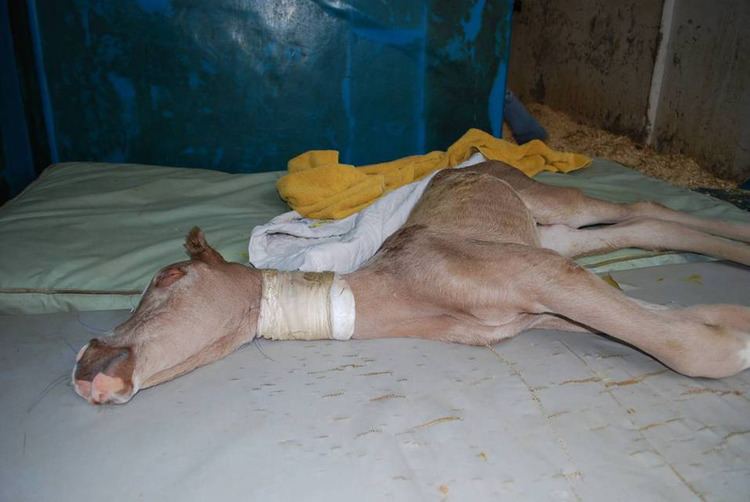 | ||
Lavender foal syndrome (LFS), also called coat color dilution lethal (CCDL), is a genetic disease that affects newborn foals of Arabian horse bloodlines. Cases reported in peer-reviewed veterinary literature are entirely of foals descended from a number of "Egyptian Arabian" or Egyptian-related bloodline groups. However, in Australia, a few breeders of Crabbet-related lines have also had foals affected by LFS. Lavender foal syndrome should be considered in any weak newborn Arabian or part-Arabian foal, particularly if it has some degree of "Egyptian" breeding, if the foal cannot stand, if other signs of neurological problems are present, and especially if it has an abnormally light coat color.
Contents
History and research
The condition has been recognized since the mid- to late-1950s.
Research into the genetics of LFS has been conducted at the University of California, Davis and Cornell University in the United States, the University of Queensland in Australia, and the University of Pretoria in South Africa. In November, 2009, Cornell University announced a DNA test has been developed to detect carriers of LFS. Simultaneously, the University of Pretoria also announced they had developed a DNA test. Testing is now available at Cornell, Pretoria, Queensland, and in New South Wales.
Clinical signs
The condition gets its name because most, though not all, affected foals are born with a unique coat color dilution that lightens the tips of the coat hairs, or even the entire hair shaft. The color has variously been described as a silver sheen, a dull lavender, a pale, dull pinkish-gray, or pale chestnut. This dilution differs from gray foals because grays are born a dark color and lighten with age. It is also different from roan, because the hair is of a uniform shade, not of intermingled light and dark hairs.
Foals with LFS are unable to stand, and sometimes cannot even attain sternal recumbency (to roll from their side to lie upright, resting on the sternum, a precursor position to standing). They may lie with their necks arched back, make paddling motions with their legs, and often have seizures. They are usually euthanized within a few days of birth. There is no cure. In some cases, the mare may also have difficulty foaling, though foaling difficulties are not the cause of the condition.
Inheritance
Lavender foal syndrome is most commonly thought to be created by a recessive gene. When a horse is heterozygous for the gene, it is a carrier, but perfectly healthy and has no symptoms at all. If two carriers are bred together, however, classic Mendelian genetics indicate a 25% chance of any given mating producing a homozygous foal, hence affected by the disease. It is hypothesized, though untested, that LFS may be linked to another genetic disease that affects Egyptian-related Arabians, juvenile epilepsy. This theory has been raised because of a small number of horses that have produced both LFS and epileptic foals.
LFS is one of six genetic diseases known to affect horses of Arabian bloodlines. Genetic diseases affect other horse breeds, including different coat dilution lethals, such as lethal white syndrome. In addition, the color white in horses, when created by certain alleles of "dominant white" (W) gene, may possibly be fatal if homozygous.
